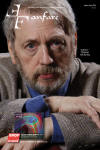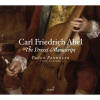Texte paru dans: / Appeared in:

Fanfare Magazine 33:4 (03/04 - 2010)
Pour
s'abonner / Subscription information
Les abonnés à Fanfare Magazine ont accès aux archives du
magazine sur internet.
Subscribers to Fanfare Magazine have access to the archives of the magazine
on the net.
Glossa
GCD 920410

Code-barres / Barcode: 8424562204102
The great portrait and landscape artist Thomas Gainsborough was a good friend of Carl Friedrich Abel. That likely explains why Gainsborough’s fine portrait of Abel was displayed at the Royal Academy in 1777. It also accounts for the presence of the Drexel Manuscript in Gainsborough’s musical archives: 29 pieces written by Abel for viol da gamba solo. The composer was an intimate of fashionable London society throughout much of the last two decades of his life, once Johann Christian Bach and he began their famed series of subscription concerts in 1764. Curiously, Abel—a sensitive and technically astonishing performer on his chosen instrument by various accounts, even when he was thoroughly drunk—published very little music for the viol, despite issuing numerous collections of symphonies, concertos, and chamber music. History suggests vanity may have been a motive. With increasing age, Abel commented repeatedly that his playing had no equal. It’s just possible that he withheld jotting down compositions to prevent comparison in these works with other performers.
Certainly Abel was regarded at the time as a master at improvisation, and it’s likely that three examples of the older-style prelude, in a freely rhythmic, arpeggiated manner, survive in the Drexel Manuscript. Along with an “aria,” and a brilliant and complex fugue, they represent the Baroque part of this collection. To the other side are the three adagios that recall the slow movements of galant symphonies, six minuets, and a range of graceful Italianate numbers. Another “aria” is brighter, simpler, and suited to a very short set (at under three minutes) of well-constructed variations; was it, perhaps, the torso of something Abel spun out with ease and extravagant invention after resuming his concerts without his late collaborator, in 1785? The finished quality of many of these movements shouldn’t make us overlook the fact that the Drexel Manuscript as a whole was a workbook rather than a grouping of completed pieces.
Of the 29 pieces in the Drexel Manuscript, all in Abel’s own hand, 28 are performed by Paolo Pandolfo. One is omitted: a six-bar fragment that could hardly be called a composition, and may have been awaiting Abel’s elaboration in the manuscript at some future time. Another, that he includes, is a prelude-style piece lasting roughly 20 seconds. At the other end of the spectrum are selections in excess of four and five minutes in length, fully developed in their structure, and demanding a high level of skill from the performer. There is a clear sense of their ongoing nature in the odd disposition of keys: 21 successive pieces in D Major, then five in D Minor, then one again in D Major, and finally two in A Major. Several in similar tempos are close to one another, and their arrangement here in suites is purely arbitrary.
Without exception, these pieces are difficult to perform. Most call upon reserves of dexterity in fingering and bowing that are more commonly encountered in French viol works of earlier generations, while several, notably the Drexel slower movements, depend at least in part upon a richness of sound and expressive dimension that, according to Ludwig Gerber, once netted Abel “a beautiful snuffbox and 100 louis d’or” in a very generous remuneration from Prince Friedrich Wilhelm II of Prussia (who also supported Mozart and Beethoven at various times). Pandolfo is equal to the task. With a suave, burnished tone and extraordinary technical resources—check out the first of two allegros, the fugue, and the adagio, all from the second D-Major Suite—he is never at a loss to cope with the most difficult hurdles provided by this delightful music. Nor is he ever at an interpretative loss for an appropriate figure or a showman-like gesture. I think it’s fair to state that if Abel played his own music with the fluency and skill Pandolfo exhibits, that snuffbox and coin would have been fair recompense.
In excellent, close-up sound, and with decent liner notes, this is a welcome release.
Cliquez l'un ou l'autre
bouton pour découvrir bien d'autres critiques de CD
Click either button for many other reviews


